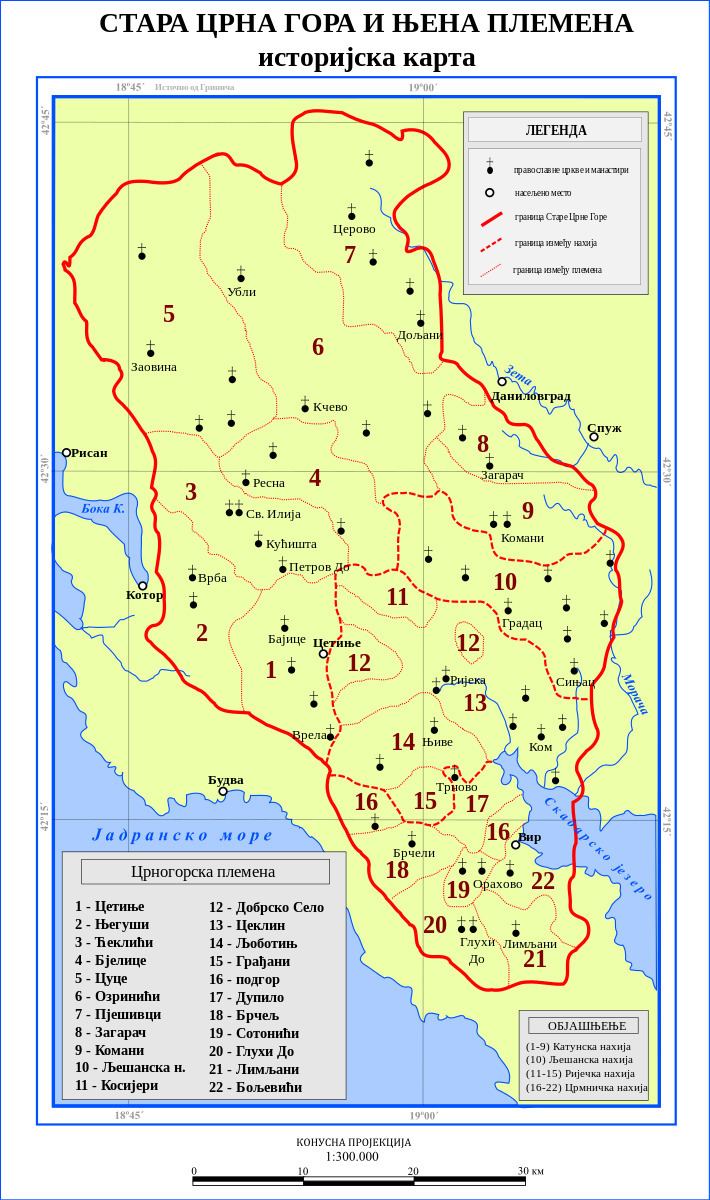Cuce (Serbian Cyrillic: Цуце, [t͡sût͡se̞]) is a tribe (pleme) of Old Montenegro, situated in the historical Katun nahiya (Katunska nahija).
The toponym Cuce is first mentioned in 1431 in documents from Kotor, then again in a chrysobull of the Cetinje Monastery from the end of the 15th century. In Ottoman defters from 1521 and 1523, Cuce is mentioned as a village. The majority of inhabitants migrated to Cuce in the 16th and 17th century, from Old Herzegovina and Old Kuči. In 1718, after the Peace of Passowitz, the Cuce along with 9 other tribes of the Katun nahiya, became de facto independent from the Ottoman Empire.
In 1829 Bjelice struggled against Ozrinići and Cuce, two neighboring tribes, and Petar I Petrović-Njegoš sent Sima Milutinović Sarajlija and Mojsije to negotiate peace among them.
Smail-aga Cengic wrote a letter in 1838 to Njegos, complaining about the Cuce who had raided Ottoman territory.
Traditionally, the Vojvode (Dukes) of tribe were from the House of Krivokapić and the Serdari (Counts) were from the House of Perović.
Jovan Cvijić extensively studied the tribes of Old Montenegro. Cuce are divided into Upper Cuce and Lower Cuce. Most of the inhabitants of Upper Cuce descend from Herzegovina, while the inhabitants of Lower Cuce generally descend from the Kuči tribe.
KovačiKovačevićiKrivokapići, brotherhood originally from Old HerzegovinaMijanovićiŠakićiZviceri, originally from Old KučiSimovićiŽivkovićiPerovićiĐuričići (oldest family in Cuce)VujadinovićiRoganovićiPerišićiPopovićiJovovićiIvanovići, brotherhood originally from Old Herzegovina, descending from Šćepan Ivanov; today all four brotherhoods are included in the Krivokapići; slava of St. NicholasMijatovićiIvanovićiZukovićiĐukanovići, base in KrajišteĐurovićiOtaševićiTomanovići, originally from Old KučiThe Djer-didije is a dance of the Cuce.
Nikac Tomanović, Montenegrin chiefSlavko Perović, famous Montenegrin politician.Ilarion Roganović, Metropolitan of Montenegro (1860-1882)Knez (Prince) Rogan, Montenegrin clan chief of Lower Cuce & eponymous founder of house RoganovićKrsto Zrnov Popović, leader of the 1919 Christmas UprisingAndrija Popović, Montenegrin politician and former water polo playerPredrag Mijatović, former Montenegrin football playerRadovan Krivokapić, Montenegrin football playerMiodrag Krivokapić, former Montenegrin football playerGoran Krivokapić, Montenegrin classical guitaristMiodrag Živković, Montenegrin politicianDragoljub Đuričić, prominent Serbian and Montenegrin musicianNenad Knežević Knez, popular Montenegrin singer, by ancestryRanko Krivokapić, Montenegrin politician, by ancestryMiodrag Krivokapić, Serbian actor; by paternal ancestryBoris Krivokapić, Serbian professor of Public International Law and Human rights and author; by paternal ancestryMilorad Krivokapic, Serbian-Hungarian handballer; by paternal ancestryMilorad Krivokapić, former Montenegrin water polo player, by ancestryAna Pešikan, former minister of science and technology in the Government of SerbiaBlažo Pešikan, former Montenegrin footballer
